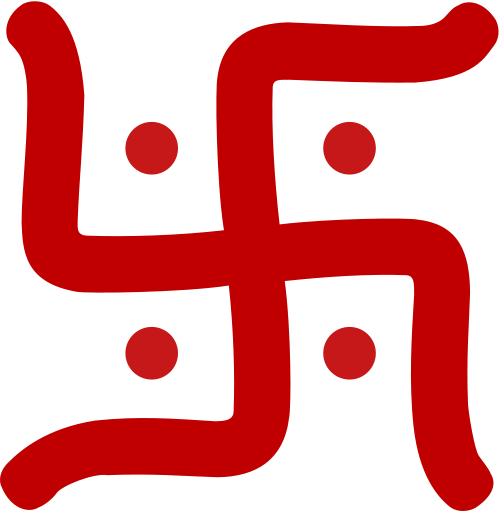
The swastika is a Hindu symbol of luck and prosperity. In Sanskrit, swastika means “that which is good.” No wonder, it is one of the most important symbols in Hinduism, but because of its use by Nazis in the Second World War, it represents hatred and has been banned in many countries.
It is made up of three parts, viz. Su+Asti+Ka where “Su” means “good” or “well” and “Asti: means “To Be” and Ka is used to make the word a noun.
It looks like a plus sign (+) bent and curved at its ends in a clockwise direction or like two uncurved Ss crossing each other in the mid. It is also used as bent and curved at its ends in an anticlockwise direction, but Hindus use it which is only in a clockwise direction. Sometimes four dots are given in four quadrants formed by the figure.
Origin of Swastika Symbol:
Its history can be traced back to the Indus Valley Civilization.
Its use can be found not only in Hinduism but also in other religions like Jainism, Buddhism, Christianity, etc. It is found in many parts of the world.
It can also be spelled as Svastica, Swastica, or Suastica.
History of Swastika:
No definitive history about its origin is available, but the earliest evidence is found in Indus Valley Civilization where it is used in ornaments. The other pieces of evidence found are:
1. The ancient city of Troy.
2. The iron age Koban culture.
3. In pre-Christian Europe and folk culture.
4. In ancient Greek designs.
As a Nazi symbol:
In 1920, the Nazi Party officially accepted Swastika as its symbol but soon after the rise of Hitler it started representing the Nazi power of Germany. Because of the massacres of Jews done by Hitler, it became the symbol of evil and people started to hate it which was very unfortunate. Its effects are still seen in the West where most of the people hate this symbol just because it was used by the Nazis.
Swastika in Hinduism:
It is an important Hindu symbol used on many auspicious occasions, like puja, marriages, Vastushanti, etc. The swastika is one of the 108 symbols of Lord Vishnu. As it is considered good luck, it is drawn on the object with Kumkum at the start of the ritual.
Swastika on Vehicles:
Some people stick swastikas made up of radium on their vehicles for good luck. On some occasions like Gudhipadawa, Dassera, Hindus wash and do puja of their vehicles. On this occasion, a swastika made up of Kumkum is drawn on the front side of the vehicle.
Swastika on Clothes:
Some people use it to decorate their clothes as well as to bring good luck. There are several designs available to be printed on clothes like T-shirts, shirts, Punjabi dresses, etc.
Swastika on the Hands of Deities:
Some deities like Ganesha, Vishnu, and others have been depicted as having it on the palms of their hands.
Swastika in Palmistry:
If you have a swastika in the center of your palm, it is believed that you would live like a king as it is considered a very auspicious sign.
Swastika in Rituals:
Hindus do a ceremony called Vastushanti before they enter a new house. In this ceremony, a swastika of kumkum is drawn on the walls of the house. In Kalash Puja, it is drawn on the Kalash.
Swastika on Building Structures:
In India, you would find several houses that have it on the front side. It is also used as a design in the houses. In the Hindu temples, it is printed on the walls.
Swastika as an ornament:
Some people use it as a design in gold and/or silver rings. It is also used as a pendant and worn in the neck with the use of metal chains and/or threads.
Swastika as a Name:
Some people prefer to give the name swastika to their businesses like Swastika Enterprises, Swastika Stationery, etc. They also have it printed on the boards of their shops. It is also used as a baby girl’s name.
Incorrect Spellings of Swastika:
As it is a very famous symbol worldwide, thousands of people search for it on the Internet. For that, they use different spellings of it. As some people are not aware of what is its correct spelling. They type it incorrectly. Following are some of the incorrect spellings of it:
Swastica, Swastic, Swaztika, Swatstika, Swasthik, Swatsika, Swatika, Swasticka, Swaztica, Swasika, Swatik, Swatstica, Swatica, Swatiska, Swastka, Swatzika, Swastaka, Swasthika, Swastick, Sawastik, Swasticker, Sawastika, Swastiker, Swatikas, Swatsticka, Swashtika, Sastik, Swazstika, Shwashtica, Zuastica, Swatsica, Swassticka, Swarstika, Swashika, Swasitka, Schwastica, Sastica, Suastic, Swastikia, Swastike, Sawastica, Swatska, Swastkia, Swasica, Swostica.